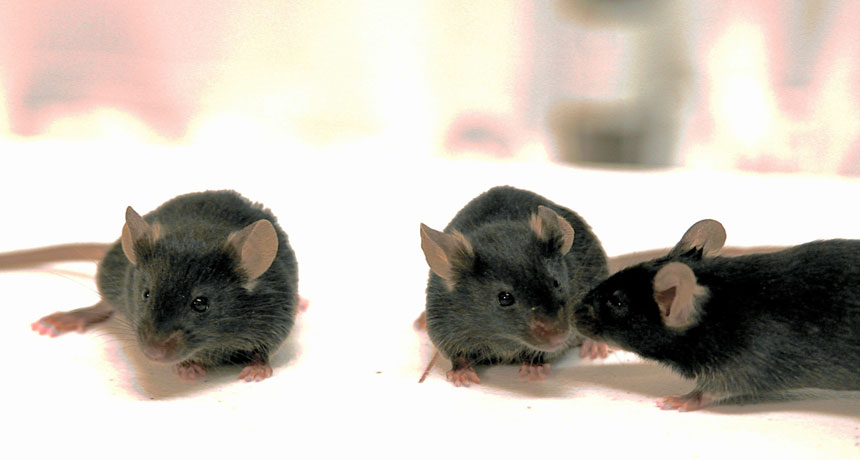Pain is contagious — at least in mice
Odor may serve as a signal that can transmit pain sensitivity from one animal to the next

Mice in pain may give off odor cues that make healthy mice nearby more sensitive to pain, too.
BORIS HEIFETS, MONIQUE SMITH
Mice can share each other’s pain. And they appear to do it through smells.
After entering the bedding where mice in pain had slept, new mice became more sensitive to pain themselves. The experiment shows that pain can move from one animal to another. No injury or illness is required.
Scientists described their findings online October 19 in Science Advances.
The results “add to a growing body of research showing that animals communicate distress and are affected by the distress of others,” says Inbal Ben-Ami Bartal. He works at the University of California, Berkeley as a neuroscientist. Neuroscientists study how the nervous system works and how it develops. The nervous system includes the brain, spinal cord and nerve cells.
Andrey Ryabinin is a neuroscientist at Oregon Health & Sciences University in Portland. He and his colleagues hadn’t set out to study the transfer of pain from mouse to mouse. But they noticed something curious during another experiment. Mice that had become addicted to alcohol were suddenly prevented from getting any more alcohol. Soon, they developed a condition known as withdrawal. It’s a set of symptoms that arise when drugs or alcohol are no longer available to an addict. Symptoms in humans include sweating and nausea or anxiety and shakiness.
In the experiment, mice going through withdrawal had a higher sensitivity to pokes on the foot. So, it turns out, did perfectly healthy mice. But only if those healthy mice had spent time in the same room as had mice going through withdrawal.
This surprised the scientists. “We realized that there was some transfer of information about pain,” said Ryabinin. It was moving from an injured mouse to its neighbor.
He and colleagues tested this pain effect some more. They poked mice in the paw with a thin fiber. The more pain a mouse was in, the bigger its reaction. And mice grew more sensitive to the paw poke when they suffered alcohol withdrawal. The same was true when they were suffering withdrawal from morphine, a heavy-duty pain reliever. It even occurred after an injection that caused tissue inflammation. Inflammation is a physical condition in which part of the body becomes reddened, swollen, hot and often painful.
Healthy mice housed in the same room as the mice in pain themselves became more sensitive to that poke of their foot. These healthy mice also showed other signs of heightened pain sensitivity.
The results are compelling evidence for the idea that pain can be transmitted socially, says Christian Keysers. He is a neuroscientist at the Netherlands Institute for Neuroscience in Amsterdam.
A sniff of pain?
Pain’s contagion seemed to spread through the nose. That’s what further experiments revealed.
After spending time in bedding used by mice in pain, a healthy mouse’s pain sensitivity spiked. Some odor signals may have been transferred from the pained mouse onto the bedding before a mouse not experiencing pain showed up and began sniffing around. Ryabinin and colleagues are looking for what the compounds might be that could relay this pain signal.
What does this research mean for humans? No one can be sure. The sense of smell in people is far less sensitive than that of many other animals. So it’s unclear whether odors might also transmit human vulnerability to pain, Ryabinin says.
The data do suggest that scent signals can carry a pain message, Keysers says. Other senses, such as hearing or vision, may be important too, he notes. Mice might see a mouse in distress or hear its pained squeaks. Still, adds Keysers, the new paper fits with other work that shows “rodents exchange information about their states in many exciting and complex ways.”
The goal of this research is to probe the means by which animals may become more sensitive to pain. Such data might help explain more generally why pain comes and goes. The new findings suggest that sometimes pain isn’t caused by an injury, Ryabinin says. Instead, social factors or cues — such as seeing another in pain — might influence pain perception.
This idea might help researchers better understand the long-term pain that can plague some people. This chronic pain may begin mysteriously or just persist long after some injury heals.







